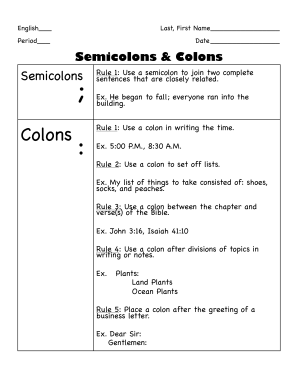Loading

Get Cornell Notes Colons Semicolons 2020-2025
How it works
-
Open form follow the instructions
-
Easily sign the form with your finger
-
Send filled & signed form or save
How to fill out the Cornell Notes Colons Semicolons online
This guide provides comprehensive instructions on how to effectively fill out the Cornell Notes Colons Semicolons document online. By following the steps outlined below, users will gain a clear understanding of each section and how to navigate the form with ease.
Follow the steps to complete the form successfully.
- Press the ‘Get Form’ button to access the form and open it in the online editor.
- In the 'Period' section, input the relevant period for which you are filling out the notes. Ensure this is accurate to maintain proper organization.
- In the 'Last, First Name' field, enter your full name in the specified format, which helps identify the document owner.
- Record the date in the provided section. This should reflect the current date when you are completing the notes.
- Review the section for semicolons and colons. Familiarize yourself with the rules provided to better understand their proper usage in your notes.
- Following the identified rules for semicolons and colons, apply these to your notes and examples as relevant.
- Once all fields are filled out and content is drafted, review your notes for accuracy and completeness.
- When satisfied with the document, save your changes, and choose to download, print, or share the form as needed.
Complete your documents online today and enhance your note-taking efficiency!
When you encounter a colon (:), follow it with relevant explanatory information, a list, or a quote. It's essential to ensure what follows the colon directly relates to the preceding statement. Incorporating colons effectively can elevate your writing and note-taking. Utilize Cornell Notes to practice proper usage and enhance your overall writing skills.
Industry-leading security and compliance
US Legal Forms protects your data by complying with industry-specific security standards.
-
In businnes since 199725+ years providing professional legal documents.
-
Accredited businessGuarantees that a business meets BBB accreditation standards in the US and Canada.
-
Secured by BraintreeValidated Level 1 PCI DSS compliant payment gateway that accepts most major credit and debit card brands from across the globe.


